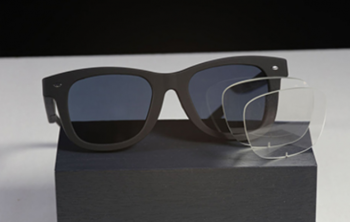
Luxexcel, Dutch pioneer in 3D printed ophthalmic lenses, has achieved a major milestone in volume manufacturing, after reporting that its manufacturing platforms in the U.S. and Europe have printed over 50,000 prescription lenses for customers in the traditional and smart eyewear, and high-tech industries. The company also announced that this achievement was the result of optimizing the patented 3D printing processes on its unique VisionPlatform turnkey technology systems, making volume manufacturing of prescription lenses more predictable, scalable, and flexible.
Since its foundation in 2009, Luxexcel has focused on making the leap from regular glasses to smart glasses by integrating technology inside a prescription lens. Thanks to its innovative VisionPlatform, it has become the first commercial company worldwide to 3D print unique and custom prescription lenses. In fact, Luxexcel holds patents to some of the main technologies required for 3D printing lenses. These make up the core of their VisionPlatform, which includes a 3D printer, called VisionEngine, a collection of custom resins for printing lenses, and proprietary software for designing and 3D printing traditional or smart lenses with glasses wearers’ individualized prescription requirements.
“All components of our volume manufacturing solution seamlessly work together to ensure that customers and partners can 3D print lenses in volume,” indicated Guido Groet, Chief Strategy Officer (CSO) at Luxexcel. “Together with our customers, we’ve now proven that VisionPlatform is stable, and offers scalability with the flexibility to create large volumes of lenses with individualized specifications, and prescription power.”
Groet also suggested that customers and partners can produce unique lenses with Luxexcel’s VisionPlatform, which aren’t possible to manufacture with legacy eyewear technologies. Even the process is more efficient than legacy lens production technology, replacing about 30 process steps in the lab, and eliminating waste by 90%. In fact, the traditional eyewear industry has serious limitations that require huge inventories, complex supply chains, and limited product design, and all the while people are continually turning to custom glasses.
3D printing technology can have a major impact where there is a need for volume and individual customization, which is exactly what the eyewear industry requires. The unlimited design possibilities, coupled with optimized production processes and less stock build-up are ideal. Particularly, Groet described that customers expand their offerings with eyewear when they use Luxexcel’s VisionPlatform, making better products with enhanced smart-tech features and functionality that also address the vision correction needs of glasses wearers.
Luxexcel can do this thanks to its unique patented 3D printing technology that embeds waveguides, electronics, sensors, and films inside the lens and print prescription power on or around it. According to the company, the smart tech is fully encased in its unique lens material as it is 3D printed. The product is durable and thin and looks like conventional eyewear, unlike some of the earliest versions of smart glasses, like Google Glass, the augmented reality headsets that failed with consumers in 2014 because they looked too science-fictiony to wear out in public, or Snapchat Spectacles, which overestimated demand but failed to deliver on augmented reality capabilities.
Both of these first takes on smartglasses failed to address one major consumer segment, the four billion users that require vision correction, which is roughly 60% of the world population. Even now, with so many companies turning to the growing smart glass industry, it is nearly impossible for all the smart glass manufacturers to stock everyone’s vision correction requirements, so prescription needs to be made on-demand, indicated Luxexcel. And for companies that make the wearable technology without the prescription lens, that means glasses wearers will have to use one set of glasses on top of the other.
During its pilot phase in 2018, Luxexcel printed 5,000 lenses per year. Since then, the business has taken its technology to another level, with commercial lenses being shipped to customers every day. Looking to expand its business, the Eindhoven, Netherlands-headquartered business introduced its volume manufacturing solution to 3D print smart prescription lenses to the smart eyewear market in September 2020 and has subsequently strengthened its leadership team to support this move. The company claims it is now geared to enable high-tech companies to make a better smart eyewear product while at the same time, addressing the vision correction needs of their customers.
Luxexcel’s CEO, Fabio Esposito, has described the company’s mature volume manufacturing solution as an enabler to combine prescription requirements with smart technology to create regular-looking lenses. He also said that the platform is scalable and offers the flexibility to create large volumes of products with individualized specifications. As a result, smart devices such as waveguides, holographic films, and LCD screens are embedded inside a lens and prescription power is printed on the top or around it, seamlessly integrated.
Luxexcel’s unique 3D printing technology offers new opportunities to differentiate and create custom lens products. At this rate, we can expect the technology to mature enough to soon enable a high volume 3D printing that will make the product available to the mass-consumer market.


